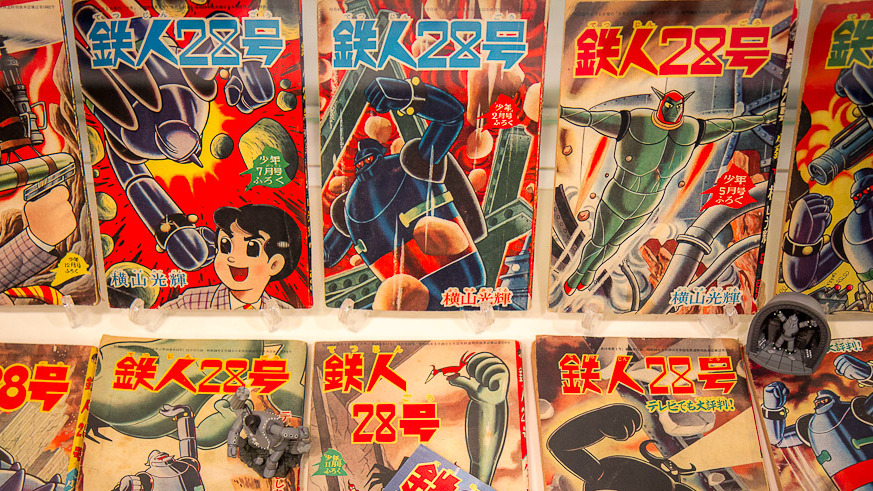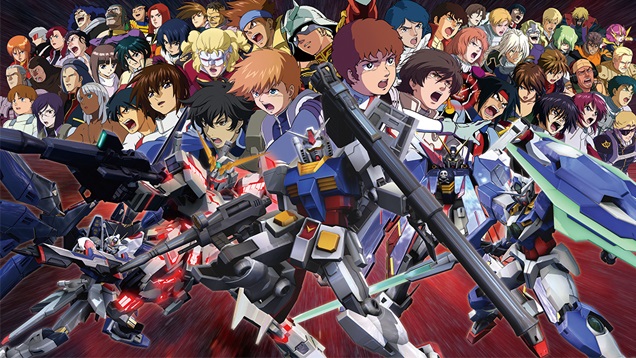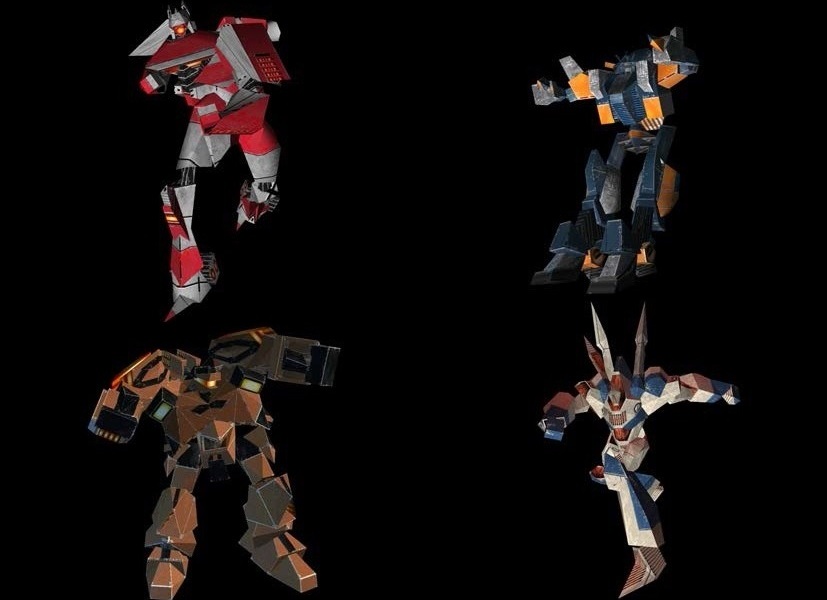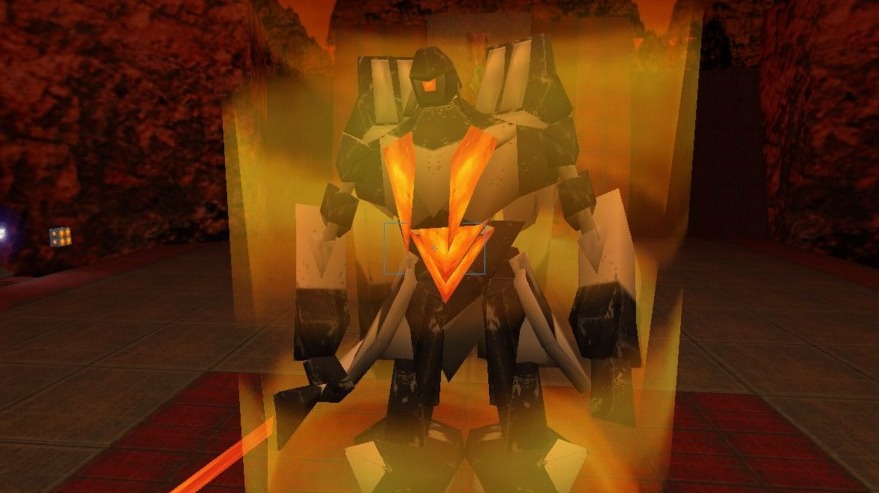In the early 2000s, the Japanese government started to evaluate the value of the country’s popular culture industry following international successes in anime/manga such as Pokémon and Dragonball, videogames like Nintendo’s Legend of Zelda and Super Mario series, and films including Spirited Away (2001) and Ringu (1998). Realizing that its cultural influence expanded despite the economic setbacks of the Lost Decade (from 1991 to 2000), Japan sought to promote the idea of ‘Cool Japan’, an expression of its emergent status as a cultural superpower.
For the next dozen years, the Japanese government made use of its soft power and ‘Cool Japan’ strategy to boost cultural exports from its creative industries, including one of its oldest and most influential anime genres: mecha (an abbreviation for the English word ‘mechanical’).
The origins of Japanese mecha can be traced to the end of World War II, when Japan witnessed the destructive power of modern technology in the form of atomic bombs that obliterated Hiroshima and Nagasaki. During Japan’s Occupation and post-Occupation years (1945-early 60s), an explosion of artistic creativity occurred in the manga industry, possibly aided by the medium’s exclusion from U.S. Occupation censorship policies. One artist, Mitsuteru Yokoyama, took advantage of this loophole to craft one of the most influential mangas of all time.
Yokoyama was motivated to become a cartoonist following the breakthrough success of Osamu Tezuka’s Mighty Atom (Astro Boy, 1952), the story of an android who fought crime with mechanical powers yet was capable of displaying human emotions, essentially acting as an interface between man and machine. Yokoyama took a different approach, drawing heavily from his childhood encounters with war, technology, and film.

The result was Tetsujin 28-go (Iron Man No. 28, 1956), a parable about technology’s dangers and benefits. It told the story of Shotaro Kaneda, a boy detective who fought criminals by commanding the titular robot by remote control. Their adventures were depicted in fast-paced, action-filled panels reminiscent of a well-edited action film.
Much of Tetsujin 28-go’s appeal could be attributed to the strong bond between Shotaro and Tetsujin, enhanced by the robot’s benign and knight-like design, suggesting an avatar of unstoppable justice. Tetsujin 28-go was the first instance of a Japanese cartoon based on the idea of a giant humanoid robot controlled by a human being, with the former acting as a tool for the latter to use for realizing his fullest potential. This concept could be seen as a metaphor for a resurgent Japan, reawakening like a giant from the rubble of WWII.
Man-machine union
If Yokoyama established a link between man and machine with Tetsujin 28-go, then Go Nagai forged that link into a union. One day, while waiting to cross a street, Nagai contemplated the backed-up traffic and mused about how the drivers were wishing for some way to get past the other cars. This inspired a novel idea: what if the car suddenly transformed into a robot that a person could ride and control like a regular vehicle? Nagai’s concept—a pilot sharing the body of a robot—made the man-machine bond both figurative and literal. The resulting manga, Mazinger Z (Tranzor Z, 1972) would prove to be the next big evolution in the mecha genre.
Mazinger Z told the story of Koji Kabuto, an orphaned schoolboy who stumbles upon the titular giant robot in his grandfather’s secret lab. The robot’s name evoked the image of a majin (demon god) with its similar-sounding syllables (‘Ma’ meaning ‘demon’ and ‘Jin’ meaning ‘god’), reinforcing the idea of a machine built by humans in need of protection that also appears as an ancient, unfathomable being.
Mazinger’s appearance was striking for its time: a brightly colored mechanical juggernaut ornamented with a mixture of military equipment and samurai armor. Its design resembled the sleek new roadways, bullet trains, and skyscrapers being built in Japan during the 1970s. A small hovercraft docked on the robot’s head housed Koji, who acted as its ‘brain’. This established Mazinger as an extension of the pilot’s abilities and will, symbolizing a powerful symbiosis between man and machine.
Before the decade ended, another development in the genre appeared that surpassed Nagai’s work. Created by Yoshiyuki Tomino, Mobile Suit Gundam represented a massive shift in both tone and scope. In place of isolated weekly episodes, Gundam presented a continuously developing story with a more ambiguous sense of morality that targeted the lines between good and evil and the effects of war on the people who fought. Instead of humans using machines to fight off evil aliens, Gundam had humans fighting humans, with both sides having their own ideological motivations. This new approach led to the splintering of the mecha genre into two subgenres: Super Robot and Real Robot.
Whereas Super Robot stories focus on near-godlike mechs in fantastical scenarios, the Real Robot subgenre emphasizes drama, human characterization, a realistic civil-war-in-space backdrop, and plausible mech creations that required adjustments and repairs. This could lead to moments when the protagonist might actually lose a battle if their machine was not properly operated and maintained. This, again, is in contrast to Super Robot works, which depict mechs as near-invincible entities that only seem to sustain damage when needed to drive the plot.
Unlike clunky, lumbering Western mechs, Japanese mechs were anthropomorphic and highly mobile entities. They espoused recognizable classes of people—snipers, soldiers, knights, etc.—including symbols of Japanese culture like the samurai. This can be seen on the RX-78-2 from Mobile Suit Gundam, which sported a fluted helmet and a skirt of armored plates on its torso.

Motion was equally important. Like the samurai sword, the mobility of Japanese mechs was managed by the user within, whose own bodily control and prowess determined the mech’s amplified analogues of human action. This granted the mechs a striking agility as the humans inside the mechs became empowered. The Japanese mecha philosophy promotes the idea of having people work alongside humanoid machines, a desire associated with Japan’s long religious history and culture.
Much like the Western superhero genre, with characters such as Superman inspired by Judeo-Christian ideals of an anthropomorphized God, the Japanese mecha is influenced by East Asian religion. Both the Shinto concept of revering natural phenomena as kami (gods) and the worshipping of carved images of Buddha in Japan suggest the protean notion of inner energy that can manifest itself in a mechanical form that may showcase some human traits. This is the Japanese mech’s most distinctive characteristic: it is the tool through which its pilot expresses their power and will to overcome by bonding with the machine. This union imbues the mech with a ‘soul’, gratifying both the pilot’s need and the viewer’s fantasy of technological power, authority, and competence.
Shogo: Mobile Armor Division
Shogo: Mobile Armor Division offers an example of a Western first-person shooter that captures the thrilling essence of Japanese mecha works like Patlabor and Venus Wars by combining speedy mechs with the fast-paced gameplay of Doom (1993). Released in 1998 by Monolith Productions, Shogo puts players in the shoes of Sanjuro Makabe, a wise-cracking commander in the United Corporate Authority, who is emotionally recovering from an accident that killed his brother Toshiro and childhood friends Kura and Baku.
From the outset, Shogo displays many of the characteristics of anime. On booting up the game, the player is treated to an anime-style movie sequence, accompanied by a Japanese pop song that was developed from rough drafts received from a Japanese publishing company. The lyrics embody typical anime themes of courage, perseverance, and optimism, idiomatically juxtaposed with the over-the-top action shown on-screen.
The audiovisual design is equally noteworthy. Unlike other 3D games released in the late 1990s, Shogo adopts a distinctively anime-inspired art style for its characters, visual effects, and environmental props. The large, bright eyes of the characters, grandiose explosions, and in-game mock advertisements are characteristic of the anime aesthetic, as are the cheesy one-liners, hand-wringing angst, and cocky humor of the dialog. This is especially apparent in Sanjuro’s conversations with allies like Kura, and foes like Samantha Sternberg, a Fallen soldier who repeatedly assaults Sanjuro throughout the game:
Kura: “Watch my ass!”
Sanjuro: “My pleasure.”
Kura: “You say the sweetest things!”
Samantha: “We meet again!”
Sanjuro: (After defeating Samantha for the third time) “I think you need to get over this obsession; it’s not healthy.”
But Shogo’s anime influences go deeper. Upon close inspection, references to several popular anime series become evident. In the second level of the game, the names of certain characters are borrowed wholesale (e.g. Isamu Dyson from Macross Plus, Rick Hunter from Robotech, Noa Izumi from Patlabor). Posters and billboards for ‘CURV’ and ‘War Angel’ directly allude to Neon Genesis Evangelion and Battle Angel Alita respectively.
In addition to its audiovisual design, Shogo displays strong mecha anime influences in its narrative, which is appropriately chaotic, conspiratorial, and convoluted. The plot contains many sudden twists and turns that leave Sanjuro questioning his alliances and objectives as he is caught in a conspiracy that will determine who gains control of Cronus, the mineral rich planet on which Shogo takes place, and its resources.
The tone of Shogo leans heavily towards Gundam and Real Robot. The United Corporate Authority (UCA) intergalactic security forces, the Cronian Mining Consortium governing body of Cronus, and the Fallen paramilitary terrorist group all have their own legitimate reasons to fight one another. The Fallen, in particular, become less antagonistic in the eyes of the player through a late-game revelation that unveils the Fallen’s raison d’etre: to front the interests of a superbeing known as Cothineal. This underground creature is the secret source of the precious kato ore that litters Cronus, and is trying to regain freedoms accidentally stolen from it by the colonizing conglomerates.
Further complications arise from Sanjuro’s commanding officer who gradually becomes irrational in his attempts to eliminate the Fallen. This places Sanjuro in a dilemma he must deal with near the end of the game when given the ability to choose one of two paths: either bring the religiously zealous Fallen leader Gabriel to justice, or help him seek a truce with the UCA to put a peaceful end to the conflict.
All of these audiovisual and narrative elements serve to imbue Shogo with a distinct mecha anime ‘feel’ that balances drama and playfulness, a feat made all the more impressive by the game’s Western origin. But Shogo’s real appeal and biggest nod to the mecha genre lies in the four Mobile Combat Armor (MCA) suits that players can choose from and pilot throughout their adventure.
The MCAs in Shogo: Mobile Armor Division reflect the aforementioned Japanese philosophy of suggesting combat classes, such as the Akuma’s ‘scout’ look and the Predator’s ‘assault’ design, and display a mix of Real and Super Robot elements. On one hand, the MCAs reflect their industrial origin through the name of their manufacturing firm (e.g. Andra Biomechanics) and classification numbers (e.g. Mark VII). On the other hand, two of the MCAs bear Super Robot-style names that refer to malicious supernatural beings: Akuma means ‘evil spirit’ in Japanese, and Ordog is Hungarian for ‘devil’.

The mecha anime influences can also be felt in Shogo’s high-octane gameplay. Unlike most ‘90s mecha videogames, Shogo married its mecha theme with first-person action inspired by id Software’s Doom and Quake. This choice of perspective allows the player to ‘become’ the pilot/MCA, cementing the man-machine bond as they navigate battles filled with visual flourishes typical of mecha anime. These include the trading of shots while closing in and circling hostile mechs, ‘Itano Circus’ missile swarms (named after the animator Ichiro Itano who pioneered the effect in Macross), and massive explosions that fill up the screen. Each firearm offers unique particle effects that serve to further evoke the dramatic combat seen in mecha anime series like Robotech and VOTOMS.
While inside an MCA, Sanjuro is capable of performing virtually all of his on-foot moves, including crouching, jumping, strafing, picking up and switching firearms on-the-fly, hovering, and even swimming. This allows Shogo’s MCAs to mimic the speed and nimbleness of conventional first-person shooters like Unreal Tournament (1999) and Rise of the Triad (1994).
The high level of mechanical maneuverability brings up another important aspect of Japanese mecha design: the notion of the mech as ‘body armor’, intrinsically connected to the human body. While Shogo’s MCAs express mechanical agility and technological prowess, they also display human elements in their design that go beyond their anthropoid architecture. When shooting an enemy MCA, for instance, hostile mechs stagger and recoil as if alive, making the MCA more of an exoskeleton than a bipedal tank by reinforcing the identity of the mech and its pilot.
Sanjuro is sometimes accompanied by two friendly MCAs on his missions, recalling the three-unit teams found in mecha series like Special Armored Battalion Dorvack and Metal Armor Dragonar. This archetype reinforces the fact that the player is just another cog in the war effort, despite their character’s high military ranking. Like Noa Izumi from Patlabor, Sanjuro is not a child prodigy endowed with superhuman abilities or enhanced reflexes. As such, Sanjuro still needs to watch his back while engaging similarly skilled opponents.
This idea of an even playing field is reflected in Shogo’s critical hit system, which came directly from Japanese role-playing games. Although this system allows the player to occasionally deal more damage than usual and earn a health bonus when scoring critical hits on enemies, the system also grants these abilities to enemies. The player cannot afford to let their guard down, particularly since Shogo’s battles pit the player against multiple adversaries. When one-on-one fights do occur, it is against stronger foes like Ryo Ishikawa, the game’s antagonist, who fills the role of the rival pilot, much like Code Geass’s Suzaku Kururugi. The differences between ‘regular’ and ‘mano a mano’ combat are tied to the player’s level of improvisation and choice of combat approach. These elements reflect the game’s focus on the ability of the player, and not on the technological capacity of their MCA.
By transplanting one of Japanese pop culture’s most iconic media forms to the quintessentially Western first-person shooter genre, Shogo gives the player the opportunity to experience firsthand the chaotic action and drama typical of mecha anime, and live out their own power fantasies by ‘becoming’ the pilot/machine. Through the game’s use of the first-person perspective, the inputs of the player, motions of the robot and emotions of the pilot become one. This seamless mixture of Eastern themes and Western game mechanics makes Shogo a distinctive achievement. It actually feels like an interactive version of an over-the-top mecha series, a testament to Monolith’s strong understanding of Japanese mecha.
The future of mecha
Nearly 20 years following Shogo’s release, the mecha gaming scene has grown increasingly more diverse over time. Games like Steambot Chronicles (2005) and Xenoblade Chronicles X (2015) spiced up their role-playing formula with mechanized gameplay, titles like Zone of the Enders (2001) and Strike Suit Zero (2013) feature fast-paced combat in wide-open spaces that allow for multi-angular movement, and releases like Hawken (2012) and Titanfall (2014) adhere to the same first-person shooter formula that has powered Monolith Productions’ take on the mecha phenomenon. This wide-reaching expansion of the mecha genre showcases a desire by game studios to emulate the thrills and/or explore the themes of mechanized combat from various design and gameplay perspectives. With upcoming mecha-themed titles like the Kickstarter-funded Battletech, Muv-Luv, Titanfall 2, and PlayStation 4/Xbox One port of Hawken, and rumors that From Software is possibly working on a new Armored Core installment, the mecha gaming landscape shows no signs of withering or stagnation.

But for all the gaming developments that have expanded and fostered the mecha scene, Shogo still manages to stand out from the pack by remaining the only mecha title, and one of the few games overall, to seamlessly blend Eastern cultural elements with quintessentially Western game mechanics, which results in the game possessing a unique “spark” derived from the essence of both its mecha anime and first-person shooter influences. Such a spark imbues the entire experience with a peculiar sense of character seldom seen in games—let alone mecha titles or shooters in general—one that cheekily accentuates its Japanophilic charm with the wanton gore and destruction emblematic of old-school, arcade-style shooters like Doom and Quake, which in turn fuels the pilot/robot bond already made conspicuous by Shogo’s first-person perspective.
It is such that now, rather than trying to split the cultural distinctions of art forms from different countries, game makers can travel across the world taking bits and pieces of things they learn and enjoy, and then glue them together in their work to expand their creative possibilities beyond the confines of their native culture. Through this unique philosophy, the multifaceted mecha genre can provide a slew of games that make use of distinct perspectives to portray mechanized warfare in a novel and intriguing light.
Shogo: Mobile Armor Division is available on GOG.com.
